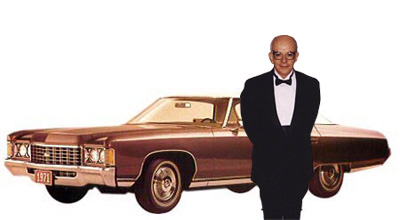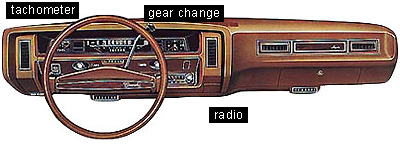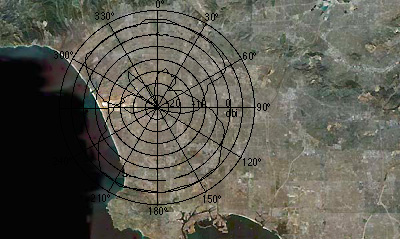

picture: Chevrolet Caprice and member of the Los Angeles Philharmonic Orchestra Caprice For Prepared Car - a performance honouring the works of John Cage. "Caprice For Prepared Car" is a performance conceived for the "monument for the media art master" (MMAM) competition, an imaginary artistic competition curated by Prof. Erkki Huhtamo. The competition's aim is to conceive a monument which reflects both, in content and form the unique contribution John Cage has made to the field of media art. John Cage was born in Los Angeles in 1912 where he started to work on his first musical pieces being influenced by the Futurists' notion of sounds. In 1938 Cage composed the first prepared piano piece, shortly after publishing his first manifesto "The future of music" in 1937. John Cage was fascinated by the idea of using noise for musical scores and treated those sounds as musical instruments. For the prepared piano Cage used everyday objects like screws and erasers to produce sounds. He manged to produce sounds with a piano that are normally associated with rhythm instruments respectively that were unheard before. Listening to the prepared piano already hints at Cage's interest in rhythm and percussion. His 1951 piece "Imaginary Landscape" was basically written for twelve radios - the idea of placing new electronic mass products into a different context introduced the radio as musical instrument for the first time. In 1952 Cage wrote "4'33''" (four minutes and thirty three seconds of silence), a piece which was performed by David Tudor for the first time and which was about the reception of music, emphasizing the noise and the dynamics in the audience instead of providing a musical score in the traditional sense itself. 
The idea of chance operations also played a major role in John Cage's work. However Cage did not only concentrated on music but influenced almost all forms of creativity. In the 1960s he worked together with Fluxus artist all around the world, and was musical advisor for Merce Cunningham's Dance Company. In his later years Cage was strongly influenced by Asian Zen philosophies and Buddhism. John Cage died in New York in 1992. 
The work "Caprice For Prepared Car" focuses on key ideas of Cage's work. It is not a physical monument like for instance a sculpture or a piece of architecture, but instead, taking the idea of most of Cage's projects, it is a performance. It consists of a specially prepared car, a Chevrolet Caprice Sedan (year of construction 1971) as an archetype icon for automobiles (like Joseph Beuys for a time drove a Bentley because of ist hood ornament in the shape of a hare). The car is specially prepared in a way, that the speed and the gear change as well as the use of the turn signal influence the sound which is produced by the car radio. The car radio itself can be manipulated in that the station changes (mostly by driving around and entering other radio stations' coverage areas, not so much by changinging the station manually). The sound of the car's motor and other elements like clutch, turning signal and so on... is added to the sound that the radio produces. Taking these elements into consideration the car is treated like a musical instrument. Like in Cage's piece "Imaginary Landscape No.4" where Cage introduced the radio as musical instrument for the first time the car also requires a professional musician (from the Los Angeles Philharmonic Orchestra) to drive it. For the performance the musician is dressed up in his work dress, a black tuxedo with white shirt. The location for the performance is Cage's hometown Los Angeles. In order to make the project accesible to many people the performance, which will last for two hours, it is being recorded onto video tape and broadcasted on TV. Video and TV were main points of interest for early 60s media artist who were also influenced by the works of John Cage. Nam June Paik was one of the first artists to use live video broadcasting systems in an artistic context and the founder of "Spazialismo", Lucio Fontana, declared the TV in his 1952 manifesto "Manifesto Spaziale Per La Televisione" as an artistic medium. 
The picture above shows the transmission area of a Los Angeles based radio station, with varying signal strengths. Each time the car passes transitions between different signal strengths the car radio's audio signal is being influenced - the car works like a scanner scanning audio signals which are transmitted by the radio station. Back to the beginning of the 20th century, Filippo Tomaso Marinetti, one of the founders of the Italian Futurist movement introduced a new concept to the art world: the beauty of speed and the aesthetics of a roaring machine. His manifesto "Le Futurisme" was a three column article on the front page of the well known French newspaper "Le Figaro" on February 20, 1909. It can be seen as one of the starting points of media art. In 1913 Luigi Russolo followed this idea by publishing "L'Arte Di Rumori", a manifesto for "The Art Of Noise". He supported his theoretical concepts of pure noise as a potential for art by physically building noise machines, so called "Intonamurati". It took another 20 years from there and the invention of the radio that Filippo Tomaso Marinetti together with Pino Masnata published "La Radia", the first manifesto for the artistic usage of the radio. However only a few radio plays were realized, here the concept was more important than the actually realized artworks. Cage was strongly influenced by these early ideas of the Futurists - he took over and refined the concept of "using noises, anything that produced sound, as a musical instrument" (John Cage in an interview with Richard Kostelanetz, 1985). The notion of sound and speed logically leads to the automobile as another instrument in the process of creating art. Again the Italian Futurists were the precursors in this domain being fascinated by the beauty of racing cars. Soon other artists took over the idea. Xanti Schavinski for example used his 1950s convertible to draw lines by driving through large color spots. In 1969 Wolf Vostell the famous German Fluxus artist realized the project "Ruhender Verkehr" (inactive traffic) in collaboration with the Cologne-based gallery "art intermedia". Vostell paved over a parking car - the car's radio was turned on - in a parking spot in Domstrasse, Cologne. Other artists, e.g. Klaus vom Bruch used the car dynamically - his car equipped with a radar unit, he visited several famous places in Germany, e.g. the Kölner Dom (the cathedral in Cologne) and made radar scans of the places. These transformed images of well-known spots all over Germany were then exhibited as video tapes in an installation called "Radar Room". A project on which I myself worked together with the German artist Harald F. Müller focused on the car as an extension and accessory for video and photo cameras. During a two week excursion to industrial areas in Italy and Southern France in June 2001 we were interested in observing and documenting architectural elements of the 50s, 60s and 70s. The car played a major role in the process of filming and taking photographs. Nearly all of the footage was shot out of the car - the car was used as a dolly, sound system and lighting set at the same time. Taken all these examples into account "Caprice For Prepared Car" not only honours the works of John Cage by pointing at some of his unique ideas contributing to the evolution of media art; in a broader sense the performance contains key elements of media art works over the past 90 years, and - going back to John Cage - shows the tremendous impact Cage's ideas had on the history of media art. back | fwinkler UCLA |